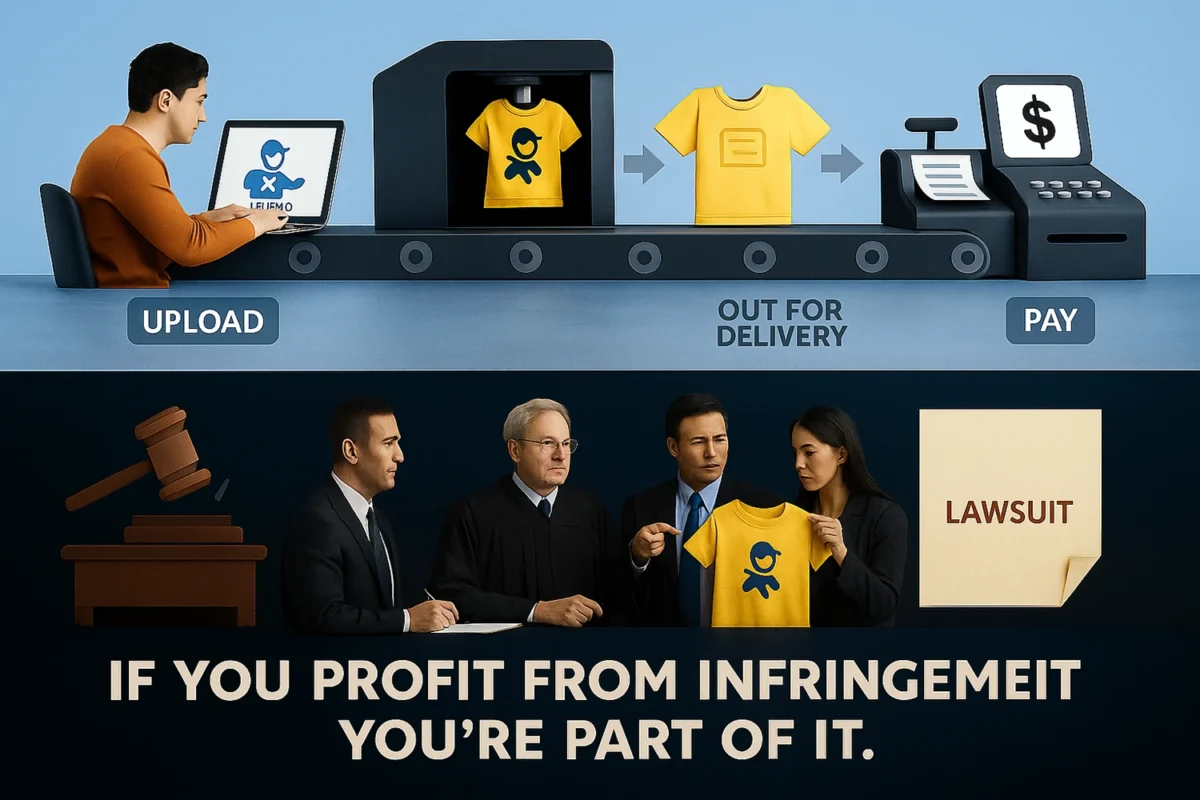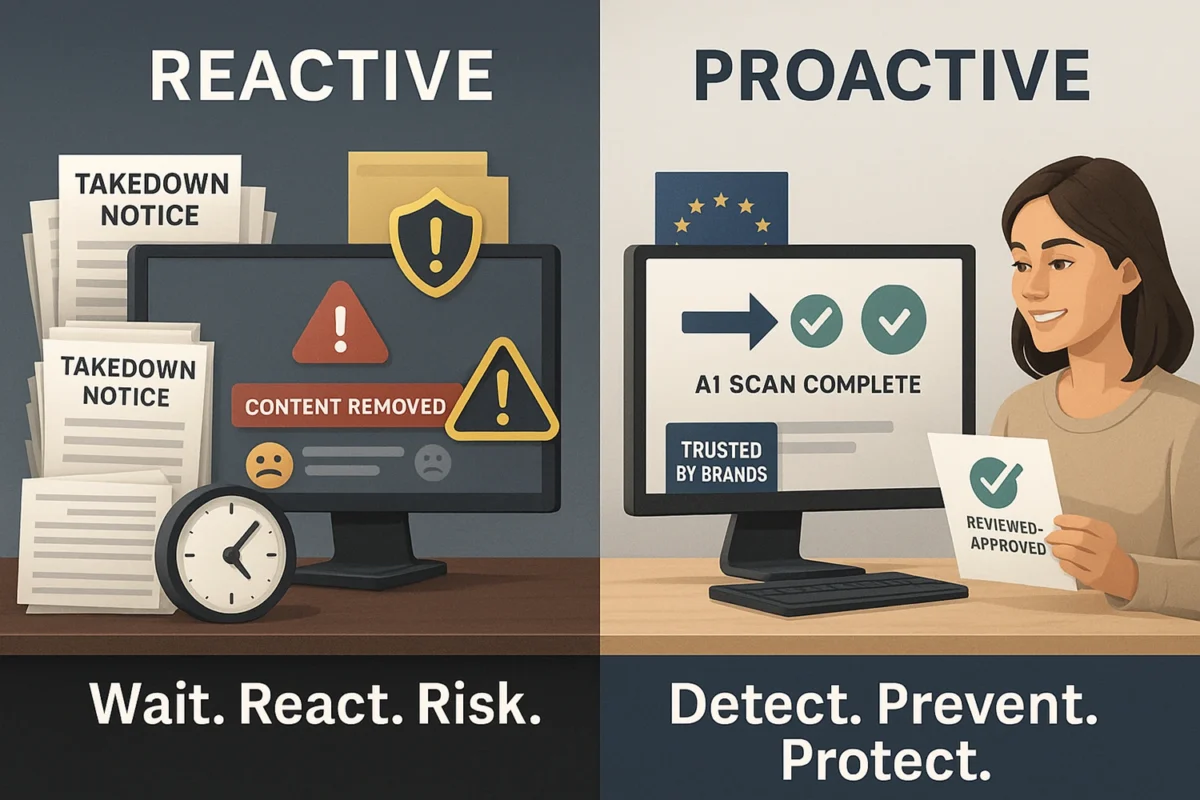Building An IP Policy That Holds Up In Court
Every content-driven platform knows it needs an IP policy.
But here’s the difference between checking a box – and building a policy that actually protects you in court:
- Clear
- Enforced
- Documented
Whether you’re running a marketplace, UGC platform, or print-on-demand (POD) service, your IP policy is your first line of legal defense. Here’s how to structure it right.
1. Clear Policy Against IP Infringement
Start with clarity: your platform does not tolerate IP infringement.
A legally sound IP policy should explicitly:
- Prohibit uploading or selling content that violates copyright, trademark, or design rights
- Define what constitutes infringement (e.g., unauthorized logos, characters, slogans, derivatives)
- Apply consistently to all users, creators, and sellers
- Reserve the platform’s right to remove content and suspend accounts
- Reinforce that users are responsible for ensuring they have rights to use the content they upload
Tip: Include examples of violations (e.g., fan art, altered logos, “inspired by” designs) to remove ambiguity.
A vague policy won’t protect you. A clear, enforceable one shows you take IP seriously.
2. DMCA Requirements: What the Law Expects
If you operate in or serve users in the U.S., the Digital Millennium Copyright Act (DMCA) requires specific elements to qualify for Safe Harbor protection:
Repeat Infringer Policy
- Define what counts as a “repeat infringer” (e.g., 3 valid takedowns in 90 days)
- Explain how repeat offenders will be warned, restricted, or removed
- Enforce this consistently and document each case
Notice & Counter Notice Process
- Provide a clear path for rights holders to report infringement
- Respond promptly and take down reported content
- Notify the uploader and give them the chance to file a counter notice
- Reinstate content if the dispute isn’t escalated in 10–14 business days
(For full detail, see Notice-and-Takedown Systems: Legal Requirements & Best Practices.)
Designated DMCA Agent
- Publicly list your platform’s DMCA contact
- Register with the U.S. Copyright Office
- Keep that record up to date with any staff or legal changes
If you don’t meet these minimums, you risk losing Safe Harbor – even if your content moderation is otherwise strong.
3. Records of Enforcement Actions: Document or Risk It
A policy only works if you can prove you follow it.
That means maintaining:
- A log of all takedown requests and responses
- A record of repeat offender enforcement actions
- Timestamped moderation decisions, including approvals or rejections of disputed content
- Evidence of any proactive efforts, such as AI detection (e.g., Infringio scans) or keyword blocks
If a brand or regulator challenges your policy, your records are your proof that you’re a responsible intermediary – not a passive host.
No documentation = no defense.
Conclusion: A Real IP Policy Isn’t Just Text – It’s Process
To protect your platform from legal claims, you need more than a pretty paragraph in your Terms of Service.
You need:
- Clear rules
- A working enforcement mechanism
- Documentation of action
- Alignment with legal standards (like DMCA and EU DSA)
Tools like VISUA’s Infringio help enforce these policies at scale – by flagging risky designs before they go live and providing visual evidence for moderation teams.
Because when your IP policy gets challenged, it’s not the words – it’s the execution that matters.
Want to enforce your IP policy with context-aware, scalable automation? Book a demo with VISUA today to see how Infringio works.
Disclaimer: Not Legal Advice
This content is provided for informational purposes only and does not constitute legal or professional advice. The information reflects our understanding as of the date of publication and may not apply to every situation or jurisdiction. You should consult qualified legal counsel for advice tailored to your specific circumstances. Any actions taken based on this content are at your own risk. Neither VISUA nor its affiliates accept liability for any losses or damages arising from the use of this information.
Book A Demo
RELATED
Redbubble, Teespring, and the Lessons of IP Enforcement Failures
Reading Time: 3 minutesPrint-on-demand (POD) platforms empower creators to design and sell products without holding inventory. But with that power…
BlogHow AI Is Changing the Game in IP Enforcement
Reading Time: 2 minutesIP enforcement used to be simple: But today’s infringement landscape – especially for POD and UGC-heavy platforms…
BlogThe Future of IP Compliance – Proactive vs. Reactive Models
Reading Time: 2 minutesFor years, most platforms treated IP compliance as a reactive function: But the market – and the…
Blog


